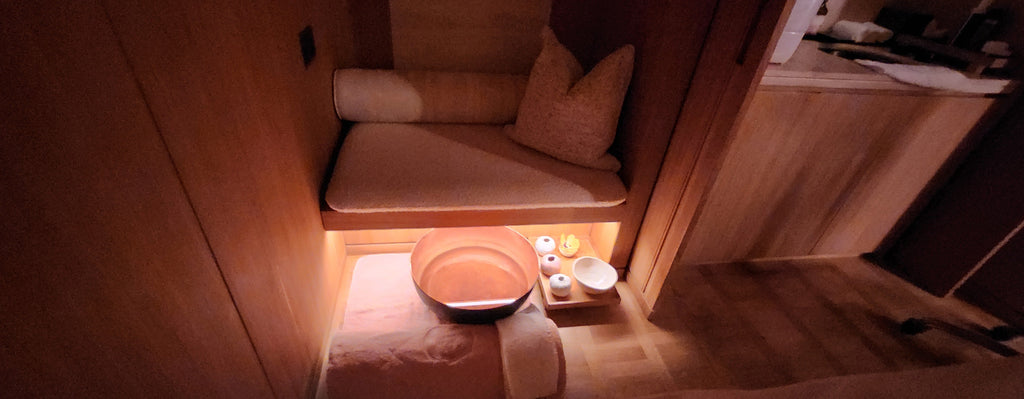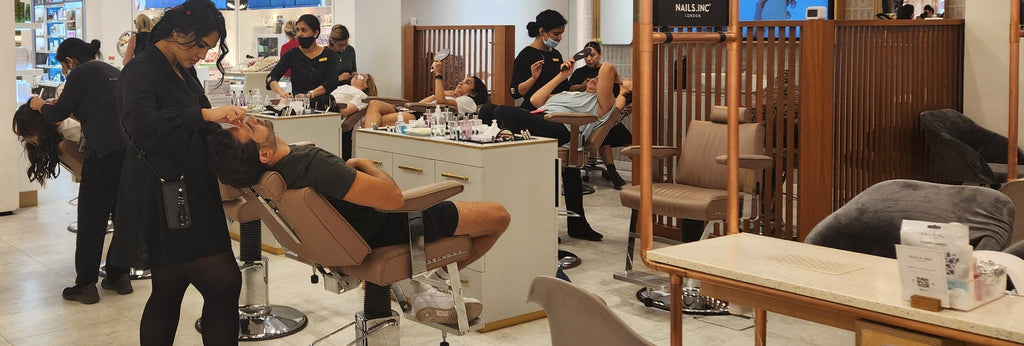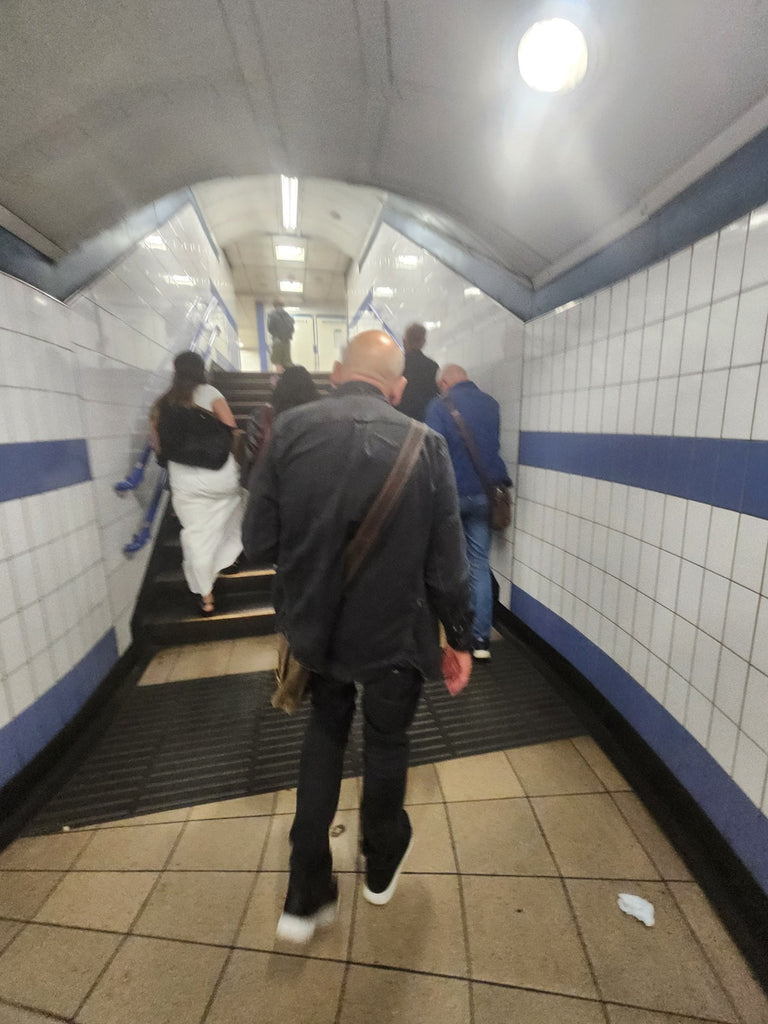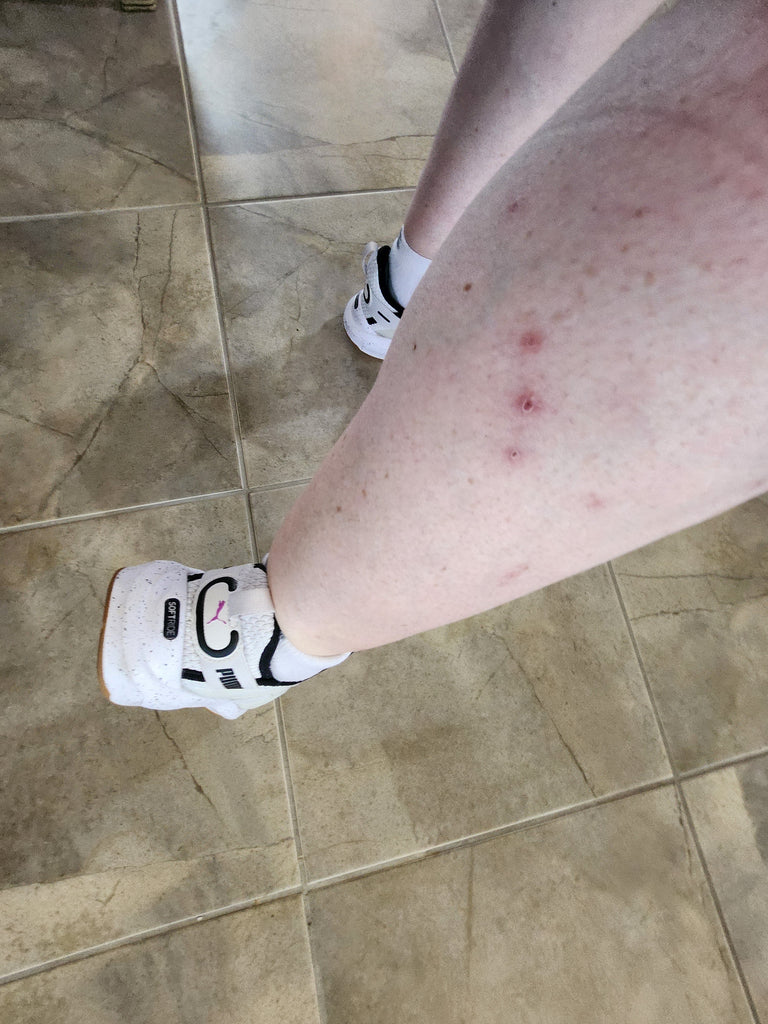Before looking into the spa, I went to Claridge's Hotel and enjoyed breakfast in their dining area (near the hotel entrance), prior to going downstairs to view and book in the spa. Claridge's is supposed to be known for their world class service, and my excellent experience at breakfast confirmed that feeling.
I took the elevator down to the basement to get to the spa. When I exited the elevator, the first thing I saw was this amazing visual art, pictured below. You have to walk towards it to enter the spa reception area.

After going around the corner, the receptionist greated me with a smile and asked if she could help. I told her I was interested in booking some services, and that I own a school that teaches CE hours to massage therapist, cosmetologist and other licensees, and she responded that she was happy to hear that I was personally visiting them. She asked if I wanted a tour which I accepted, and then she proceeded to show me their swimming pool area which she said could be used for two hours if a 90-minute spa service was booked.
She then brought me back to reception where we started reviewing the different spa services they had to offer. Her first and strongest recommendation was for their Bamboo & Silk Ritual which is £330 pounds in 2025, and what she called their "signature service." On the Claridge's website, the service is described as a "total mind and body immersion". It's advertised to provide the following over their 90-minute appointment:
- a welcoming foot ceremony
- a nurturing silk facial
- a trilogy of body and hand massage techniques
- an invigorating bamboo body massage
- seasonal herbs within hot oil-infused poultices
- a deep hand massage
After we decided I would schedule their signature Bamboo & Silk Ritual appointment for the following day, she asked for my details such as name, phone, email, etc. I handed her a business card and she said I would need to finish the appointment electronically to hold it. That means they wanted my credit card. So I told her I would wait to receive their email to enter my credit card details, given I was in a foreign country and wanted to make sure my credit card worked on their electronic platform.

The establishment is littered with private sitting areas, so she asked if I would like to have a seat while she setup the appointment and I accepted. She asked if I wanted some water while I waited which I also accepted (pictured above.) Water was served in a thick quality plastic cup which is standard for pool area beverages, or for areas where clients are barefoot so that they do not injure themselves if a drinking glass were to break on tile, marble or hard floors in the massage, spa or ammenities spaces. I received their email on my phone to finish entering my credit card data to hold the appointment and I completed it there in the sitting area. She then requested that I show two hours prior to my appointment so that I could enjoy their ammenities first, which I did.
I arrived well before my service was supposed to start to smiling women at reception. They checked me in and then showed me back to the ladies locker room that included a cold shower room, steam, sauna and there were large cubicles with regular showers, sink and toilet, as if it’s your own private bathroom with door.
Pictured next is their private cubby bathroom area:

This is their steam room:

And their sauna:

With cold shower. It is setup similar to a Roman waterfall shower that can be adjusted for hot or cold:

All of those water and bath amenities pictured above are in the ladies locker room. The ladies lockers are pictured next and stocked with a one size fits everyone bathrobe, flip flops and towel:

She asked if I wanted any tea, nuts or fruit and I gladly accepted. The tea was in a paper cup for the same reason they use plastic drinking cups. The nuts were delivered in a sealed bag which is excellent for sanitation or clients in the area with a nut allergy. The bag of nuts also had dried fruit, and it was labelled with allergens in bold print too which was extremely conscientious of the facility.

Most spas would have some type of bowl with nuts and a dispenser which are not self-contained, have sanitation issues, and are a risk to those who have allergies too. So this is an excellent job and effort on behalf of this spa and massage establishment.
On a side note, London overall seems more sensitive about allergens than the United States. In restaurants, they ask if you have allergies, and then they even ask about cross contamination if you’re food order doesn’t contain your allergen, they want to make sure you’re okay if the allergen was stored in the same cupboard or refrigerator with what you ordered, given some cannot have cross contamination without serious consequences including death. One restaurant, The Albert in downtown London even had me sign on their tablet about my allergy.
The lockers were fairly standard for an upscale spa, but there wasn’t a second privacy door or corner to the ladies locker room, so anyone standing just outside the ladies locker room could see directly into anyone changing directly in front of their locker which is fairly common practice. You had to use the bathroom cubbies for privacy from outside male guests.
I changed into my bathing suit, used the pool and relaxed at the one of the pool cabanas where both regular and lemon water with more fresh fruit was provided.


Towels are plentiful with extra amenities and well appoined touches provided. The spa has made excellent use of common area space for seating:

I then showered prior to my appointment and enjoyed their aromatherapy body wash, shampoo and conditioner. It was a perfect heavenly aromatic blend of rose, petitgrain and clove essential oils. You can view the aromatherapy products standarly provided to the right of the shower in the pic below:

My appointment then started on time with a very kind and well-groomed practitioner. She reviewed medical conditions with me before we started and had me sign her tablet that the medical intake was complete.
My signature service was supposed to start with a footbath, but I told her I had just showered and she saw that I had used the pool, so she gave me the option to have the foot bath first, or start on the table, and I opted for the table to receive more table time. She did have the foot bath set up and ready to go if I had opted to use it, pictured below. The foot bath was a large copper bowl with still water, and essence to the side to choose or use.

The therapist then explained the order of my treatment which would include massage, poultice treatment, bamboo massage and then a quick facial.

The treatment room and entire spa is beautiful with simplistic yet elegant blush beige tones. The massage or bodywork table had a hole in it for the face rest which was okay but not great. The opening felt fairly small so I asked for an additional towel so that the upholstery seam was not digging into my jaw. The table itself might have been 40 inches wide, and the widest table I have ever seen for massage or spa bodywork.
Electric massage tables of that width usually cost a small fortune, and are more difficult for a smaller practitioner with a smaller client, because they have to reach further to apply more pressure during massage appointments. Wider tables are usually more comfortable for clients, so this establishment probably opted for this extra wide table to continue top notch service for their clients. The table was covered with extremely high thread count linens and very soft padding including a beautiful top blanket for warmth.

After massaging my back with oil, she then proceeded with a heated poultice treatment. Two poultices began with dapping heat onto my back. I forgot where she started with them; however, proper procedure would start on the upper back, working your way down to the lower back given the lower back is the most sensitive area, so while allowing the poultices to cool with the dabbing while providing thermal therapy, they should be started at the top, working your way inferiorly to the sacrum.
After the hot poultices cooled, she then began to massage my back with warm poultices which felt really nice and exfoliating. The muslin poultice application was a perfect combination of scratchiness and pressure.
Once she finished the poultice application she moved onto bamboo massage. The bamboo was heated; however, the heat dissipated rather quickly which is not her fault. Bamboo retains heat for lesser time than other massage tools, such as basalt lava hot stones. The bamboo massage was my least favorite of the three back massage applications given its hard surface. It would be hard to chose which was better between the regular body massage or poultice bodywork on my back because both were fantastic. All three massage applications were perfectly applied, and a favorite massage style would be a personal preference over any type of functional rating.
Once she finished my back, she then moved onto one leg, and then the other, perfectly draping both one at a time. She flexed my knee during some of the calf and foot massage which felt nice with the added range of motion. She also included shoulder range of motion techniques with the back massage, by placing both arms individually up on my back to reach deeper into the rhomboid muscles.
Once the posterior massage and bodywork was complete, she had me roll over onto my back for anterior bodywork. She did lift the sheet well into the air completely exposing me, which made it easier to turn over; however, some clients might not want to be so exposed when changing position. While the sheet covered her face, it is excessive nakedness that can be easily avoided.

Then she used the electrical components of the multipurpose spa treatment table to elevate my lower legs for knee bolstering. She also place a decent sized pillow under my head to help drain my sinuses, which was wonderful after being pronated for so long during this 90-minute signature service.
She started the supinated body massage with each individual leg and foot, appropriately exposing one at a time. She then moved up to each individual arm for the same. Nothing was more remarkable or worth noting beyond what is already explained with the pronated massage. When she finished with both the lower and upper extremities, she began my facial.
The facial started with her use of the electrical table to further elevate my head. First she applied a skin cleansing balm with terrific facial massage application. It was really wonderful. She used a hot towel to remove the balm. A facial cleansing gel was applied for a second cleanse. She used all new facial massage techniques with the cleansing gel which were really unique, thorough and wonderful. She paid particular attention to my T-zone area which is brilliant during cleansing, given the T-zone would be the area that would need facial cleansing most. She removed the gel cleanser with another hot towel. It appeared their hot towels were hand mitts which are another uber expensive investment on behalf of the spa.
After removing both cleansers, she then performed two more applications which felt like a serum and moisturizer, again with perfect and more unique massage applications. Her facial massage techniques deserve 10+ stars. The serum and moisturizer appropriately remained on my face. She ended the treatment with a really strong and fantastic scalp massage.
Once she was finished, she used the electrical components of the table to help me sit upright. This makes table dismount easier. It also allows a moment for blood pressure to regulate itself and help avoid postural hypotension at the end of a long tablework session like this one. The massage therapist washed her hands both pre and post treatment for an appropriate period of time. This is 100% excellent practice by the massage therapist.
At the end of the service, I asked the practitioner if I could keep the poultices if she was going to throw them away. These shouldn’t be reused given they cannot be sanitized for another client, and any sanitation efforts would strip them of their therapeutic properties, so I was happy to take them instead of seeing them put them in the trash. But the therapist insisted on providing me with new poultices instead which is not what I asked for. I think she thought she was doing me a favor, but I would have preferred the ones that were used on me and already had oil on them, because that would have made a better bath treatment at home with the extra oil. I would always recommend providing the used herbal poultices to clients post-treatment, and recommend they add their used poultice to an at-home soak or bath for further enjoyment.


The pros of this overall service are listed throughout this review. There are too many to list again. It was a wonderful and expensive experience that justifies its price.
I don’t really have cons for this tremendous appointment, but I do have some areas of improvement, which could hit this 5 star service further out of the park:
1. I detected an extremely faint odor of bleach or chlorine in the hot towel mitts used with my facial, which is likely undetectable to someone who’s not a trained aromatherapist and practitioner like I am. It was good to know these are sanitized; however, soaking or wetting these with an herbal bath of floral waters, teas or essential oils could provide a heightened experience. Because the treatment and spa are floral oriented, I would recommend geranium, jasmine or rose essential oil in a water bath when preparing the hot towels for the cubby.
2. I’d like to see this service ended with hot towels on the feet to further remove the oil application, and cream or lotion used for the hand and foot massage. While the therapist did compress the sheet on my feet which removed some of the oil before she moved onto my upper extremities, I’d like to see more of an effort there. The oil was as perfect as one can get for hand and foot application. There were not any abrupt slips which can happen with oil when using it on these areas of the body where the skin is thickest; but it’s still oil and more slippery which creates avoidable hazards post treatment for the client with table dismount, and until the oil has lost all of its slippery properties.
3. Don’t ever let someone design a spa for you unless they’re a massage therapist or request onsite massage therapist input. The treatment space for the oversized multipurpose spa table is not large enough to allow a massage therapist to lunge or use proper body mechanics to apply greater pressure for deep tissue work. While they might be able to achieve deep tissue with improper application, it could lead to unnecessary injury for the massage therapist. A larger treatment room would also allow the spa to use a separate face rest at the end of the table instead of pronating clients into a facial hole, which has questionable sanitation and less comfort than a separated facial cradle and cushion. It’s like someone purchased the most expensive equipment or gadgets, but sometimes functionality doesn’t need the most expensive, and better function can be achieved with lesser priced items (i.e. a table at least 2 inches more narrow would be more appropriate, especially when the practitioner is on the petite side themselves.)
4. Allowing a real spa practitioner to participate in the design of the spa should allow for better judgement, especially when ordering massage equipment, for example oversized tables are expensive, unnecessary and could more easily injure staff. An experienced practitioner might also have added better privacy for the locker areas too.
5. While I can appreciate the Japanese theme that was used to create and decorate this gorgeous and incredible spa establishment which now occupies the basement of Claridge’s hotel, from the door handles to all of the striking eye-candy finishes, the attire was another matter. Guests and reception staff are dressed extremely similar, and it would be most awkward if one customer approached another for assistance, because they’re confused when everyone is dressed in similar fabric of the same colors with slightly different patterns. This is especially important when 90 minute services are promoted so that a customer can use the spa facilities including pool, free of extra charge. I would recommend dressing the staff in a light greenish bamboo colored uniform, instead of identical colors to the clients to make a better distinction between guests and staff. This might have also been done if a real spa provider helped with the overall design and acquisition of materials. In my opinion, a real practitioner did not participate in this, did not speak up during the design, or didn’t have enough experience to make these recommendations, and the establishment could have benefited even more than what they already have from such expertise and input.












































